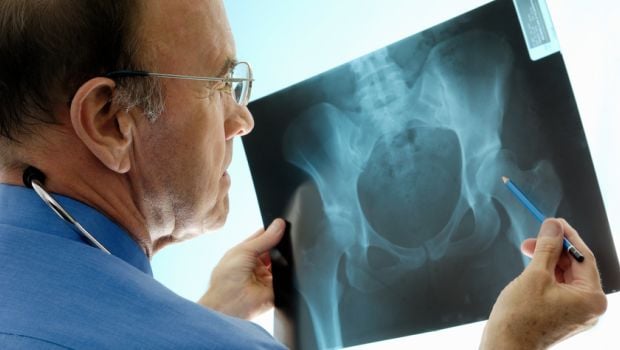For Osteoporosis, Early Treatment Is Crucial

The source of her angst is whether to begin treating her osteoporosis with bisphosphonates, drugs that are very effective at increasing bone density but carry some small risks.
These include an increased chance of developing osteonecrosis of the jaw, in which the jawbone fails to heal after a minor injury – getting a tooth pulled, for example – and of suffering an uncommon type of fracture in the femur, or upper thigh bone.
While serious, these conditions are rare. Nevertheless, Riskind is nervous. “I’ve read all the latest studies about jaw problems and femur breaks, and want to avoid taking the drugs for as long as possible,” she says.
Bone specialists worry about women like Riskind because those who fail to treat their osteoporosis face a growing danger of a debilitating hip fracture as they age.
Osteoporosis develops when the body loses too much bone or makes too little of it, or both. When this happens, bones weaken and are susceptible to breaking from a fall, or even from something more benign, such as a bump or a sneeze.
About 54 million Americans have osteoporosis or osteopenia, according to the National Osteoporosis Foundation. The latter condition is a softening of the bone, which puts a person at higher risk of developing full-blown osteoporosis. The disease results in 2 million broken bones and $19 billion in costs annually, according to the foundation.
Many fractures result from falls, the leading cause of fatal and nonfatal injuries among older adults, according to the Centers for Disease Control and Prevention. The CDC recently reported that an estimated 27,000 older adults died in 2014 as a result of falling, while 2.8 million were treated in emergency departments. Furthermore, about 800,000 of these ER patients were later hospitalized.
Experts have become very concerned about trends that show an end to the 30-year decline in the incidence of hip fractures among older American women. This trend may be caused by, among other things, a reluctance to take bisphosphonates. Moreover, they fear the numbers are going to start rising again.
“We have a crisis, not only in this country but around the world,” says Douglas P. Kiel, a professor of medicine at Harvard Medical School and president of the American Society for Bone and Mineral Research. “We are not adequately treating osteoporosis.”
Between 2002 and 2012, the annual rate of hip fractures among American women older than 65 declined steadily, from 884 per 100,000 women to 740, according to research presented at the society’s annual meeting in September, Kiel says. “However, since 2012, the rate of decline has plateaued,” he adds.
In addition to fear of the drugs, there probably are additional explanations for the changes in reported fracture incidence. In 2007, for example, Medicare cut reimbursement for all office-based imaging services, including for DXA scans – tests that measure bone density – which may have discouraged doctors from offering them to women.
“In 2006, the national average for Medicare reimbursement of DXA scans was $139,” Kiel says. “Today, the national average is $42,” he says. “There has been a marked decrease in the number of physicians who provide the test in their office,” he adds. “The current Medicare reimbursement no longer covers a physician’s costs to perform the scan, which includes the technologist’s time to perform the scan and the doctor’s time to interpret the test.”
When women aren’t tested, they won’t know whether they have osteoporosis – which means they won’t receive treatment.
“We’re trying to get everyone – patients, doctors, insurance companies and the government – all on the same page making informed decisions,” Kiel says.
Kiel says that concerns about bisphosphonates are overblown.
“A very small percentage of patients on these drugs encounter side effects, and researchers are working hard to understand how we can minimize them further,” he says. “The data are clear that these drugs prevent enormous suffering and needless deaths.
“Both men and women with osteoporosis who have had an osteoporotic spine or hip fracture are at high risk for another fracture and should be treated with medications that can substantially lower their risk of future fracture,” he adds. “It’s shocking that so many patients don’t even realize that they are at risk for another fracture.”
Some of the medicines are inconvenient to take, requiring an empty stomach and sitting or standing upright for at least 30 minutes to prevent heartburn. However, there are other options, he says.
“There are oral drugs taken weekly or even monthly, and one that does not require an empty stomach,” Kiel says. “For those who do not want to take pills, there are twice-a-year injections or once-a-year IV [intravenous] infusions. They are all effective. People see their doctor annually, so it is not inconvenient to get treated annually and then not have to take pills and get refills.”
Recently, Kiels’s society and 34 other health and medical organizations around the world called on providers, governments, insurers and others in the health-care system to ease access to screening and therapies for high-risk individuals and to increase research and education to ensure that hip-fracture rates do not increase.
“My mother died of a hip fracture that cut her life short by many years,” Kiel says. “Up to 25 percent of hip-fracture patients die within one year of that injury. Some women have said that they would rather be dead than have a hip fracture and end up disabled or in a nursing home for the rest of their lives. We can prevent both with proper screening, diagnosis and treatment of osteoporosis.”
